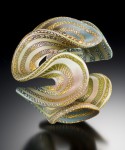How do I love thee?
Debra DeWolff, Bracelet, 2007
“How do I love thee? Let me count the ways.” *
Expressions of love are numerous and vary from culture to culture. In many cultures, not only is holding hands a tangible connection between two people, it generally is an outward sign of affection. Wearing a bracelet that encircles the wrist in a kind of embrace might be considered as a symbolic manifestation of love. Indeed, the words “embrace” and “bracelet” share the same Latin root, “brachium”, which means arm. Rings have long been symbols of commitment and a bracelet, especially a bangle, is much like an oversized ring for the arm. Although bracelets have been worn since antiquity for many reasons such as protections against evil, signs of wealth or status, and religious talismans, they always are an item of personal adornment.
As there are many forms of love, there are many, many kinds of bracelets. Bracelets made of polymer vary widely in appearance and construction. Here is a visual sampler of some distinctive examples:
Debra DeWolff’s blend of felt beads and quirky polymer leaves, flowers and baubles clearly derives from nature. Like Rebecca Zimmerman’s work, Debra’s use of color is bold and her forms are simplified and ornamented with much detail. This bracelet is fresh, playful and innocent compared to the sensuousness of Jeffrey Lloyd Dever’s work, Summer’s Opulence.
Jeffrey’s bracelet is a combination of round berry like forms and elongated pods attached to wrapped wire. The total effect is quite luscious and is reminiscent of the bounty of succulent fruits.
Lindly Haunani’s Asparagus Bracelet offers another direct association with nature. This wearable crown of double ended asparagus spears is the artist’s expression of adoration for the graceful spring vegetable. The outward curve of the red and violet tips beckons one to look closer.
Unusual exterior contours and a jolt of strong color are defining elements of Melanie West’s organic inspired bracelet designs. Her biobangle, Nudibranch, features a fluttery edge that resembles the movement of seaweed through water although the strong coral color offers a surprising contrast.
For a bit of the ultra natural, it’s hard to find anything that resembles Wendy Wallin Malinow’s Antler bracelets. These dramatic bracelets with their pointy ends and stubby bases initially appear to be very realistic. And yet they are not at all natural, since antlers cannot be bent to encircle an arm.
But the round form is part of the very essence of a bracelet. A continual loop of sensuous “S” curves is what makes Elise Winters, Ruffle Cuff bracelet such an eye catcher. The vibrant color and undulating shape work in tandem to move one’s eye around the wrist and up and down the arm.
Cynthia Toops’s Rolodex bracelets suggest a more twist and turn approach. Where Elise’s bracelet has a structured form, Cynthia’s construction is a bit more relaxed. Ultra thin sheets of clay, stacked and bound together rotate around the wrist in a fluid way with each sheet as a unique page in a unified whole.
Classic form and a decorative surface define this bangle by Seth Savarick. Seth’s smooth domed surface is an ideal means to feature a graphic linear pattern. Here, the cleanly defined form contrasts with the irregular path of the curvy ornamentation.
Caned surface patterns and a series of well coordinated components are what give Sarah Shriver’s bracelets their harmonious appearance. Each element of this well designed bracelet works together to create an overall unity of color, shape and pattern.
Sandra McCaw’s cuff bracelet also demonstrates a mastery of related patterns. Sandra’s intricately designed canes and delicate balance of color and scale draws the eye in further to study the illusions of depth and tracery.
While Sandra’s cane patterns create a sense of elaborate linear patterning, the entire structure of Pier Voulkos’s bracelet suggests pattern. A multitude of applied mini canes adorn peanut shaped forms that bob up and down in a rhythmic manner. As always, Pier’s use of color and inventive forms are hallmarks of her work.
And although there are some notable polymer bracelets absent from this Valentine’s Day sampler of selections, it is good to indulge in the array of possibilities.
* the first line from Sonnet 43 by Elizabeth Barrett Browning










